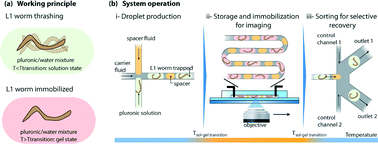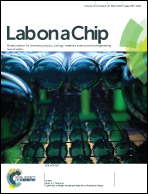Hydrogel-droplet microfluidic platform for high-resolution imaging and sorting of early larval Caenorhabditis elegans†
Abstract
The nematode Caenorhabditis elegans is an important model organism in research on neuroscience and development because of its stereotyped anatomy, relevance to human biology, and ease of culture and genetic manipulation. The first larval stage (L1) is of particular interest in many biological problems, including post-embryonic developmental processes and developmental decision-making, such as dauer formation. However, L1's small size and high mobility make it difficult to manipulate; particularly in microfluidic chips, which have been used to great advantage in handling larger larvae and adult animals, small features are difficult to fabricate and these structures often get clogged easily, making the devices less robust. We have developed a microfluidic device to overcome these challenges and enable high-resolution imaging and sorting of early larval stage C. elegans via encapsulation in droplets of a thermosensitive hydrogel. To achieve precise handling of early larval stage worms, we demonstrated on-chip production, storage, and sorting of hydrogel droplets. We also demonstrated temporary immobilization of the worms within the droplets, allowing high-resolution imaging with minimal physiological perturbations. Because of the ability to array hydrogel droplets for handling a large number of L1 worms in a robust way, we envision that this platform will be widely applicable to screening in various developmental studies.


 Please wait while we load your content...
Please wait while we load your content...